Management Information System Implementation at Tertiary College
VerifiedAdded on 2020/05/04
|11
|2889
|45
Report
AI Summary
This report examines the implementation of a Management Information System (MIS) at the Australian Tertiary College, focusing on the institution's vision statement, stakeholder analysis, and the integration of ICT in educational processes. It details the implementation plan, including a stakeholder analysis identifying key players like teachers, students, and management, and discusses the impact of the system on various stakeholders. The report explores the socio-ecosystem analysis, detailing the changes in technology and teaching methods over time, and outlines the change levers and stakeholder alignment strategies used. Furthermore, it presents a plan for change management, emphasizing the importance of team cooperation for sustainable organizational changes, and concludes with a discussion on the benefits of IS implementation and the challenges faced, offering a comprehensive overview of the MIS implementation process.
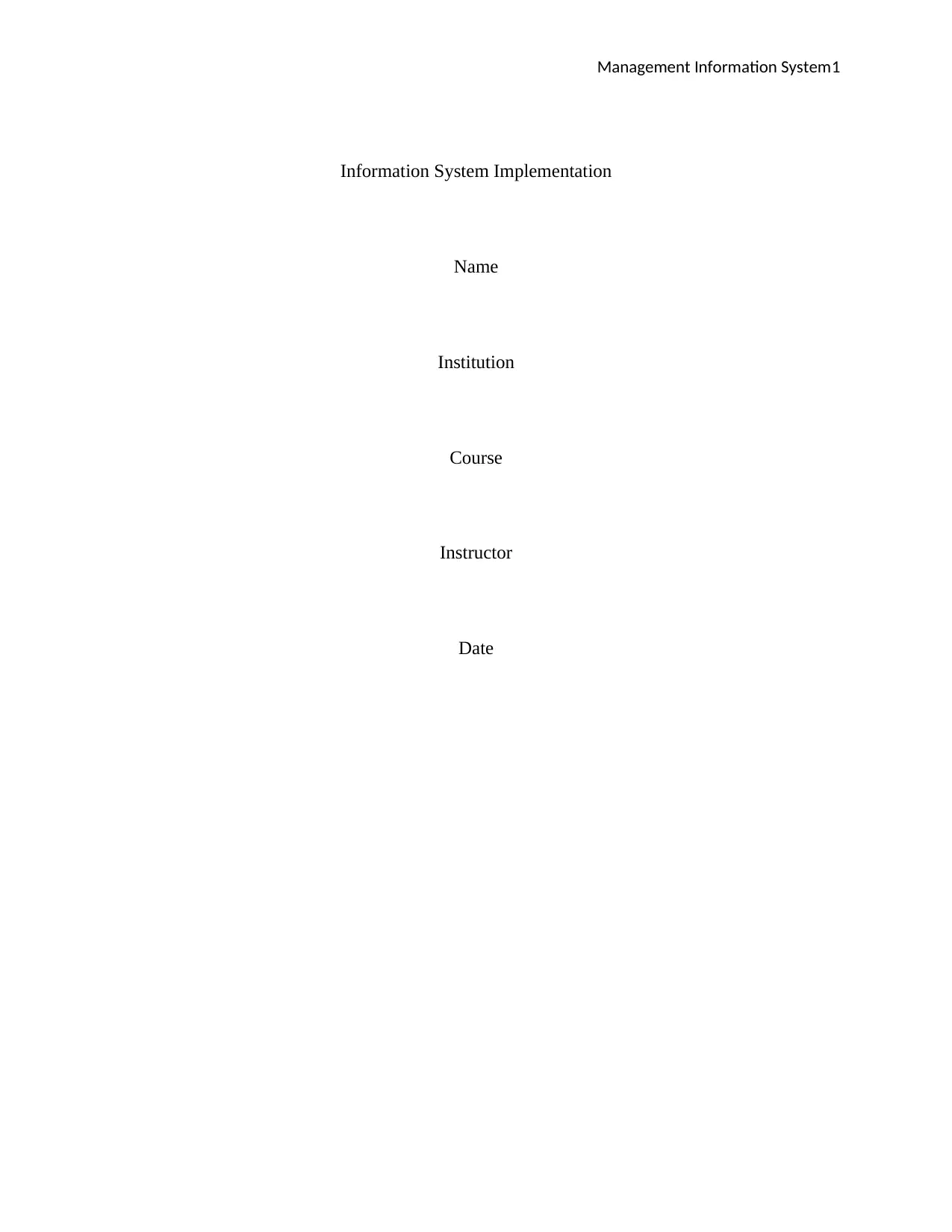
Management Information System1
Information System Implementation
Name
Institution
Course
Instructor
Date
Information System Implementation
Name
Institution
Course
Instructor
Date
Paraphrase This Document
Need a fresh take? Get an instant paraphrase of this document with our AI Paraphraser

Management Information System2
Introduction
This assignment is a discussion of the development processes in form of an implementation plan
which drove the reconstruction of an Australian Tertiary College. The main consideration in this
discussion is the reassessment of the technological level of the institution; as well as the
pedagogy which then develops the vision statement. The tertiary College’s vision statement
provides a procedure that the institution would undertake to attain its development potential. The
technological analysis involves the impacts on each and every stakeholder including the students,
parents, the organization and the staff. Other aspect of analysis that would help in the
determination of the level of development; brought about by the implementation of information
systems include socio-ecosystem analysis. The preferred Socio-Ecosystem aspect of
development happens in stages. They include:
1. 1 year
2. 5 years and;
3. 10 years
In the assignment the change levers are also determined with regards to the stakeholder
alignment strategies. The last stage of development in this case is a plan associated with change
management.
Vision Statement
The first aspect of IS Management is vision statement implementation. A vision statement is like
a path or a roadmap to follow. In another way, it may also mean a compass point showing the
direction of success. The vision of any organization focuses on the future of the same firm. The
vision statement is one important factor that influences the creation of changes. The development
of the institution in question’s vision statement lead to the creation of:
i) Dreams of the organization
ii) Interests
iii) Hopes
iv) Expectations of the organization
Aspects of vision statement include:
Introduction
This assignment is a discussion of the development processes in form of an implementation plan
which drove the reconstruction of an Australian Tertiary College. The main consideration in this
discussion is the reassessment of the technological level of the institution; as well as the
pedagogy which then develops the vision statement. The tertiary College’s vision statement
provides a procedure that the institution would undertake to attain its development potential. The
technological analysis involves the impacts on each and every stakeholder including the students,
parents, the organization and the staff. Other aspect of analysis that would help in the
determination of the level of development; brought about by the implementation of information
systems include socio-ecosystem analysis. The preferred Socio-Ecosystem aspect of
development happens in stages. They include:
1. 1 year
2. 5 years and;
3. 10 years
In the assignment the change levers are also determined with regards to the stakeholder
alignment strategies. The last stage of development in this case is a plan associated with change
management.
Vision Statement
The first aspect of IS Management is vision statement implementation. A vision statement is like
a path or a roadmap to follow. In another way, it may also mean a compass point showing the
direction of success. The vision of any organization focuses on the future of the same firm. The
vision statement is one important factor that influences the creation of changes. The development
of the institution in question’s vision statement lead to the creation of:
i) Dreams of the organization
ii) Interests
iii) Hopes
iv) Expectations of the organization
Aspects of vision statement include:

Management Information System3
i) Goals of the institution
ii) The mission of the school
iii) The philosophy of the institution
iv) Core values and cultural features
v) Performance criteria
vi) Strategies in general
vii) Decision making rules
viii) Ethical standards of employees.
On the same, this assignment is going to discuss the educational vision statement of Australian
Tertiary College on the basis of the institution’s pedagogy, curriculum, and mostly technological
level. Regarding IS Management, the institution’s vision is: “Australian Tertiary College has
fully integrated ICT in every bit of its educational processes.” Teachers have also adopted the
use of ICT devices in their educational processes (Kamboj and Singh 2015). Through such
developments, the institution has been able to provide online studies. Integrated in the
educational system is the HS1 system for management. Through this system the institution has
been able to provide academic content both to virtual and real students.
i) HS1 Management System
This is one system that has worked many institutions. Some of these institutions are federal
governments. HS1 helps in the management of information of individuals. In our IS
Management case, this system is employed by Australian Tertiary College to ensure that the
information of all stakeholders of the institution is tracked and also stored properly. According to
the vision statement, the system is centrally administered through twelve office areas. Such a
way allows the institution to track, with a lot of ease, the students’ performances and the
operations of the college.
Analysis of Stakeholder
In our study case, the stakeholders include teachers, students, the immediate community,
management and the subordinate staff. Before the implementation of the information systems,
the stakeholders have to come to a consensus that such systems will improve student
performance. Talking of ICT integration, the institution will adopt the use of ICT teaching
i) Goals of the institution
ii) The mission of the school
iii) The philosophy of the institution
iv) Core values and cultural features
v) Performance criteria
vi) Strategies in general
vii) Decision making rules
viii) Ethical standards of employees.
On the same, this assignment is going to discuss the educational vision statement of Australian
Tertiary College on the basis of the institution’s pedagogy, curriculum, and mostly technological
level. Regarding IS Management, the institution’s vision is: “Australian Tertiary College has
fully integrated ICT in every bit of its educational processes.” Teachers have also adopted the
use of ICT devices in their educational processes (Kamboj and Singh 2015). Through such
developments, the institution has been able to provide online studies. Integrated in the
educational system is the HS1 system for management. Through this system the institution has
been able to provide academic content both to virtual and real students.
i) HS1 Management System
This is one system that has worked many institutions. Some of these institutions are federal
governments. HS1 helps in the management of information of individuals. In our IS
Management case, this system is employed by Australian Tertiary College to ensure that the
information of all stakeholders of the institution is tracked and also stored properly. According to
the vision statement, the system is centrally administered through twelve office areas. Such a
way allows the institution to track, with a lot of ease, the students’ performances and the
operations of the college.
Analysis of Stakeholder
In our study case, the stakeholders include teachers, students, the immediate community,
management and the subordinate staff. Before the implementation of the information systems,
the stakeholders have to come to a consensus that such systems will improve student
performance. Talking of ICT integration, the institution will adopt the use of ICT teaching
⊘ This is a preview!⊘
Do you want full access?
Subscribe today to unlock all pages.

Trusted by 1+ million students worldwide
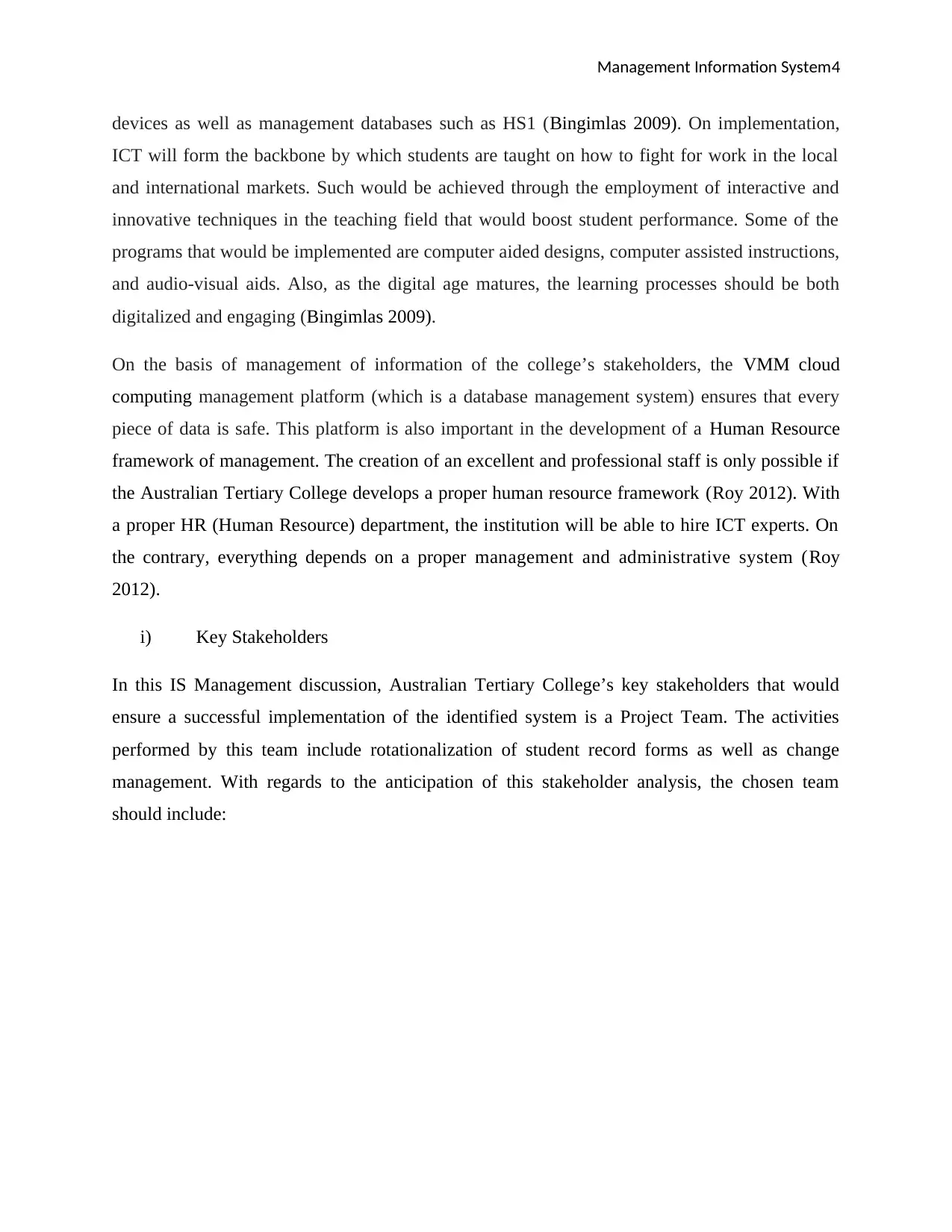
Management Information System4
devices as well as management databases such as HS1 (Bingimlas 2009). On implementation,
ICT will form the backbone by which students are taught on how to fight for work in the local
and international markets. Such would be achieved through the employment of interactive and
innovative techniques in the teaching field that would boost student performance. Some of the
programs that would be implemented are computer aided designs, computer assisted instructions,
and audio-visual aids. Also, as the digital age matures, the learning processes should be both
digitalized and engaging (Bingimlas 2009).
On the basis of management of information of the college’s stakeholders, the VMM cloud
computing management platform (which is a database management system) ensures that every
piece of data is safe. This platform is also important in the development of a Human Resource
framework of management. The creation of an excellent and professional staff is only possible if
the Australian Tertiary College develops a proper human resource framework (Roy 2012). With
a proper HR (Human Resource) department, the institution will be able to hire ICT experts. On
the contrary, everything depends on a proper management and administrative system (Roy
2012).
i) Key Stakeholders
In this IS Management discussion, Australian Tertiary College’s key stakeholders that would
ensure a successful implementation of the identified system is a Project Team. The activities
performed by this team include rotationalization of student record forms as well as change
management. With regards to the anticipation of this stakeholder analysis, the chosen team
should include:
devices as well as management databases such as HS1 (Bingimlas 2009). On implementation,
ICT will form the backbone by which students are taught on how to fight for work in the local
and international markets. Such would be achieved through the employment of interactive and
innovative techniques in the teaching field that would boost student performance. Some of the
programs that would be implemented are computer aided designs, computer assisted instructions,
and audio-visual aids. Also, as the digital age matures, the learning processes should be both
digitalized and engaging (Bingimlas 2009).
On the basis of management of information of the college’s stakeholders, the VMM cloud
computing management platform (which is a database management system) ensures that every
piece of data is safe. This platform is also important in the development of a Human Resource
framework of management. The creation of an excellent and professional staff is only possible if
the Australian Tertiary College develops a proper human resource framework (Roy 2012). With
a proper HR (Human Resource) department, the institution will be able to hire ICT experts. On
the contrary, everything depends on a proper management and administrative system (Roy
2012).
i) Key Stakeholders
In this IS Management discussion, Australian Tertiary College’s key stakeholders that would
ensure a successful implementation of the identified system is a Project Team. The activities
performed by this team include rotationalization of student record forms as well as change
management. With regards to the anticipation of this stakeholder analysis, the chosen team
should include:
Paraphrase This Document
Need a fresh take? Get an instant paraphrase of this document with our AI Paraphraser

Management Information System5
System Deliverables
The risk register of the system is shown in the table below:
However, the system’s success factors are:
1. Endorsement and funding approval from the Executive Committee or the board.
2. Appointment of the management team
System Deliverables
The risk register of the system is shown in the table below:
However, the system’s success factors are:
1. Endorsement and funding approval from the Executive Committee or the board.
2. Appointment of the management team
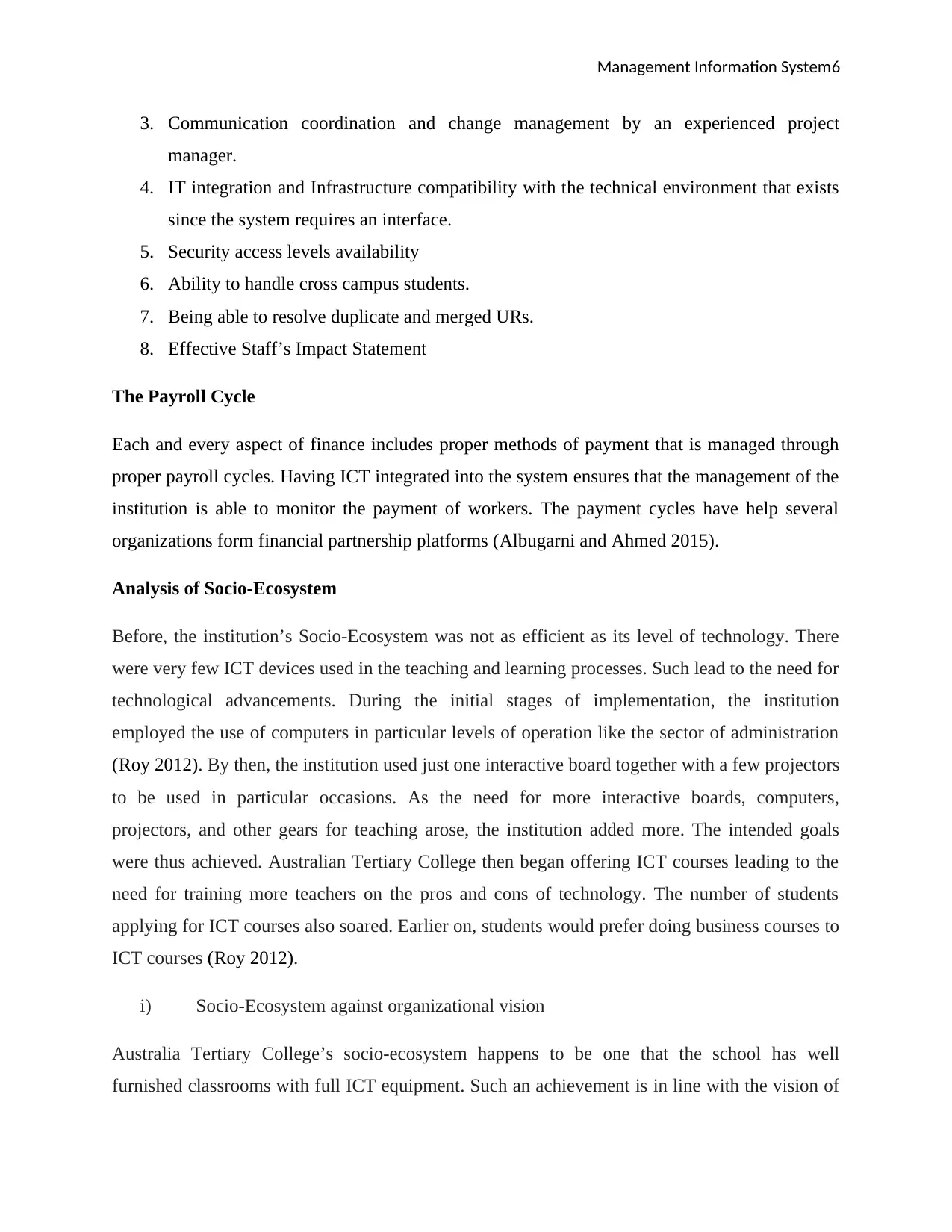
Management Information System6
3. Communication coordination and change management by an experienced project
manager.
4. IT integration and Infrastructure compatibility with the technical environment that exists
since the system requires an interface.
5. Security access levels availability
6. Ability to handle cross campus students.
7. Being able to resolve duplicate and merged URs.
8. Effective Staff’s Impact Statement
The Payroll Cycle
Each and every aspect of finance includes proper methods of payment that is managed through
proper payroll cycles. Having ICT integrated into the system ensures that the management of the
institution is able to monitor the payment of workers. The payment cycles have help several
organizations form financial partnership platforms (Albugarni and Ahmed 2015).
Analysis of Socio-Ecosystem
Before, the institution’s Socio-Ecosystem was not as efficient as its level of technology. There
were very few ICT devices used in the teaching and learning processes. Such lead to the need for
technological advancements. During the initial stages of implementation, the institution
employed the use of computers in particular levels of operation like the sector of administration
(Roy 2012). By then, the institution used just one interactive board together with a few projectors
to be used in particular occasions. As the need for more interactive boards, computers,
projectors, and other gears for teaching arose, the institution added more. The intended goals
were thus achieved. Australian Tertiary College then began offering ICT courses leading to the
need for training more teachers on the pros and cons of technology. The number of students
applying for ICT courses also soared. Earlier on, students would prefer doing business courses to
ICT courses (Roy 2012).
i) Socio-Ecosystem against organizational vision
Australia Tertiary College’s socio-ecosystem happens to be one that the school has well
furnished classrooms with full ICT equipment. Such an achievement is in line with the vision of
3. Communication coordination and change management by an experienced project
manager.
4. IT integration and Infrastructure compatibility with the technical environment that exists
since the system requires an interface.
5. Security access levels availability
6. Ability to handle cross campus students.
7. Being able to resolve duplicate and merged URs.
8. Effective Staff’s Impact Statement
The Payroll Cycle
Each and every aspect of finance includes proper methods of payment that is managed through
proper payroll cycles. Having ICT integrated into the system ensures that the management of the
institution is able to monitor the payment of workers. The payment cycles have help several
organizations form financial partnership platforms (Albugarni and Ahmed 2015).
Analysis of Socio-Ecosystem
Before, the institution’s Socio-Ecosystem was not as efficient as its level of technology. There
were very few ICT devices used in the teaching and learning processes. Such lead to the need for
technological advancements. During the initial stages of implementation, the institution
employed the use of computers in particular levels of operation like the sector of administration
(Roy 2012). By then, the institution used just one interactive board together with a few projectors
to be used in particular occasions. As the need for more interactive boards, computers,
projectors, and other gears for teaching arose, the institution added more. The intended goals
were thus achieved. Australian Tertiary College then began offering ICT courses leading to the
need for training more teachers on the pros and cons of technology. The number of students
applying for ICT courses also soared. Earlier on, students would prefer doing business courses to
ICT courses (Roy 2012).
i) Socio-Ecosystem against organizational vision
Australia Tertiary College’s socio-ecosystem happens to be one that the school has well
furnished classrooms with full ICT equipment. Such an achievement is in line with the vision of
⊘ This is a preview!⊘
Do you want full access?
Subscribe today to unlock all pages.

Trusted by 1+ million students worldwide

Management Information System7
the school. Regarding the institution’s vision, each and every classroom should have computers,
interactive boards, and other ICT learning equipment. Earlier on, the institution didn’t offer
courses associated with ICT. However, the vision states that the future of the learning and
teaching need to integrate aspects of ICT even more. Each and every course will then have to
integrate ICT. ICT will have to form the backbone of every learning process. Such is to mean
that more information systems would have to be employed.
Changes brought be the implementation of information systems
Among the myriad of changes include altering the stakeholders’ mentality as well as changing
the framework of the organization. Regarding the framework of the organization, each and every
sector need to be restructured in a way that ICT equipment are all integrated and also in full
operation. Also, regarding changing the mentality of stakeholders, all the teachers have been able
to change their strategies of teaching to have technology incorporated. Having technology added
to the teaching practice would ensure that the learning process is made easy and interesting.
Students would also learn about the importance of information systems and ICT. Teachers and
parents, as stakeholders, would also have a better chance of tracking the performances and
improvements of students (Kaur 2015). Still on the changes, research activities are performed
now and again to have the reactions of the involved parties realized. Benchmark studies are also
conducted for the purpose of determining the cons, pros, and impacts of having ICT integrated in
the education processes.
Changes within the institution:
i) In 1 year
A year after implementation, the school had already initiated sensitization programs that would
teach on the pros and cons of integrating ICT into the institution’s operational framework in
terms of the academic, management and administrative aspects. However, the institution needed
more interactive boards.
ii) In 5 years
Five years down the line, the institution acquired enough ICT equipment in form of laptops,
computers, projectors, interactive boards and tablets. Also, the institution ensures that proper
the school. Regarding the institution’s vision, each and every classroom should have computers,
interactive boards, and other ICT learning equipment. Earlier on, the institution didn’t offer
courses associated with ICT. However, the vision states that the future of the learning and
teaching need to integrate aspects of ICT even more. Each and every course will then have to
integrate ICT. ICT will have to form the backbone of every learning process. Such is to mean
that more information systems would have to be employed.
Changes brought be the implementation of information systems
Among the myriad of changes include altering the stakeholders’ mentality as well as changing
the framework of the organization. Regarding the framework of the organization, each and every
sector need to be restructured in a way that ICT equipment are all integrated and also in full
operation. Also, regarding changing the mentality of stakeholders, all the teachers have been able
to change their strategies of teaching to have technology incorporated. Having technology added
to the teaching practice would ensure that the learning process is made easy and interesting.
Students would also learn about the importance of information systems and ICT. Teachers and
parents, as stakeholders, would also have a better chance of tracking the performances and
improvements of students (Kaur 2015). Still on the changes, research activities are performed
now and again to have the reactions of the involved parties realized. Benchmark studies are also
conducted for the purpose of determining the cons, pros, and impacts of having ICT integrated in
the education processes.
Changes within the institution:
i) In 1 year
A year after implementation, the school had already initiated sensitization programs that would
teach on the pros and cons of integrating ICT into the institution’s operational framework in
terms of the academic, management and administrative aspects. However, the institution needed
more interactive boards.
ii) In 5 years
Five years down the line, the institution acquired enough ICT equipment in form of laptops,
computers, projectors, interactive boards and tablets. Also, the institution ensures that proper
Paraphrase This Document
Need a fresh take? Get an instant paraphrase of this document with our AI Paraphraser

Management Information System8
incentives such as government policies are employed in the facilitation of the ICT processes of
learning. More ICT teachers are recruited while students interested in learning ICT course would
be admitted.
iii) In 10 years
Ten years after the implementation of the information systems, the institution would have made
several positive changes. Such changes include the introduction of online courses. Another
change is the adoption of a better database management system. Such a system would be used in
three main sectors. These sectors are administrative, management and academic. The
management system is intended to increase operations efficiency. At this time, the school would
have effectively incorporated ICT in every offered course. The application for ICT courses by
students would also be massive such is due to the fact that technology would have dominated the
academic processes.
Change Levers and Stakeholder Alignment
Those involved in the institution’s educational activities are sensitized on the benefits as well as
the impacts of having proper information systems as well as incorporating ICT in the teaching
processes. Every stakeholder is properly informed on the requirements of global markets with
regards to training of ICT experts. Such a reason ensures that the institution teaches students
under international standards of management and entrepreneurial skills that are needed to make
them work anywhere in the universe (Kaur 2015). It is through technology and the aspects of
information systems management that several countries have been able to boost their economies.
Australia, for instance, uses more than US $8 billion annually to ensure that its economic sectors
are improved. Such sectors include the education segment (Kaur 2015).
Australian Tertiary College has always employed government policies and incentives for proper
information system management as well as the use of ICT to get protection from the law so as to
avoid cyber-crimes and other computer technology associated malice (Kaur 2015). Each and
every aspect highlighted in this discussion paper has been made possible by the availability of
government funds. Teachers are as well given in-service training for the purpose of boosting
their confidence when it comes to utilizing ICT teaching resources for such processes (Kaur
incentives such as government policies are employed in the facilitation of the ICT processes of
learning. More ICT teachers are recruited while students interested in learning ICT course would
be admitted.
iii) In 10 years
Ten years after the implementation of the information systems, the institution would have made
several positive changes. Such changes include the introduction of online courses. Another
change is the adoption of a better database management system. Such a system would be used in
three main sectors. These sectors are administrative, management and academic. The
management system is intended to increase operations efficiency. At this time, the school would
have effectively incorporated ICT in every offered course. The application for ICT courses by
students would also be massive such is due to the fact that technology would have dominated the
academic processes.
Change Levers and Stakeholder Alignment
Those involved in the institution’s educational activities are sensitized on the benefits as well as
the impacts of having proper information systems as well as incorporating ICT in the teaching
processes. Every stakeholder is properly informed on the requirements of global markets with
regards to training of ICT experts. Such a reason ensures that the institution teaches students
under international standards of management and entrepreneurial skills that are needed to make
them work anywhere in the universe (Kaur 2015). It is through technology and the aspects of
information systems management that several countries have been able to boost their economies.
Australia, for instance, uses more than US $8 billion annually to ensure that its economic sectors
are improved. Such sectors include the education segment (Kaur 2015).
Australian Tertiary College has always employed government policies and incentives for proper
information system management as well as the use of ICT to get protection from the law so as to
avoid cyber-crimes and other computer technology associated malice (Kaur 2015). Each and
every aspect highlighted in this discussion paper has been made possible by the availability of
government funds. Teachers are as well given in-service training for the purpose of boosting
their confidence when it comes to utilizing ICT teaching resources for such processes (Kaur
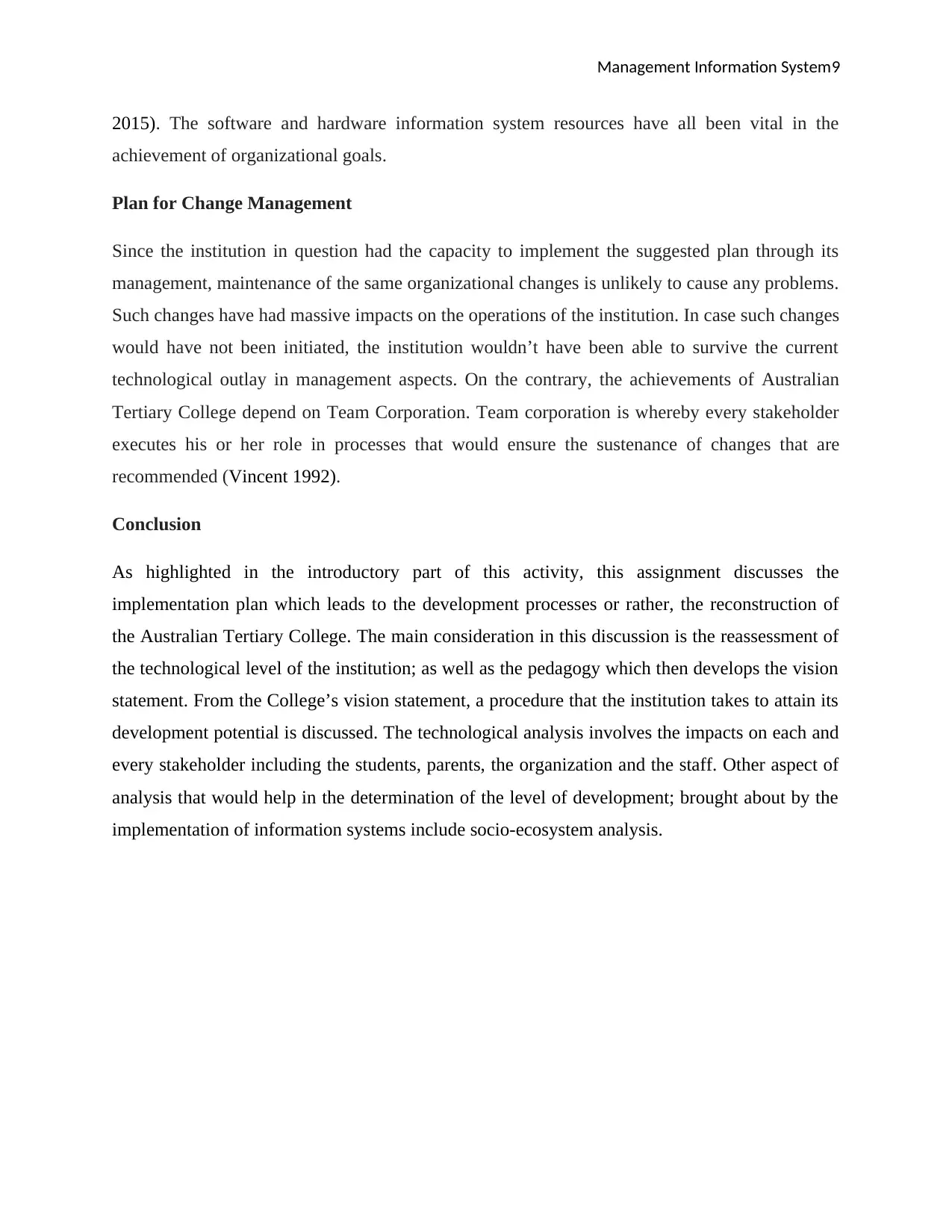
Management Information System9
2015). The software and hardware information system resources have all been vital in the
achievement of organizational goals.
Plan for Change Management
Since the institution in question had the capacity to implement the suggested plan through its
management, maintenance of the same organizational changes is unlikely to cause any problems.
Such changes have had massive impacts on the operations of the institution. In case such changes
would have not been initiated, the institution wouldn’t have been able to survive the current
technological outlay in management aspects. On the contrary, the achievements of Australian
Tertiary College depend on Team Corporation. Team corporation is whereby every stakeholder
executes his or her role in processes that would ensure the sustenance of changes that are
recommended (Vincent 1992).
Conclusion
As highlighted in the introductory part of this activity, this assignment discusses the
implementation plan which leads to the development processes or rather, the reconstruction of
the Australian Tertiary College. The main consideration in this discussion is the reassessment of
the technological level of the institution; as well as the pedagogy which then develops the vision
statement. From the College’s vision statement, a procedure that the institution takes to attain its
development potential is discussed. The technological analysis involves the impacts on each and
every stakeholder including the students, parents, the organization and the staff. Other aspect of
analysis that would help in the determination of the level of development; brought about by the
implementation of information systems include socio-ecosystem analysis.
2015). The software and hardware information system resources have all been vital in the
achievement of organizational goals.
Plan for Change Management
Since the institution in question had the capacity to implement the suggested plan through its
management, maintenance of the same organizational changes is unlikely to cause any problems.
Such changes have had massive impacts on the operations of the institution. In case such changes
would have not been initiated, the institution wouldn’t have been able to survive the current
technological outlay in management aspects. On the contrary, the achievements of Australian
Tertiary College depend on Team Corporation. Team corporation is whereby every stakeholder
executes his or her role in processes that would ensure the sustenance of changes that are
recommended (Vincent 1992).
Conclusion
As highlighted in the introductory part of this activity, this assignment discusses the
implementation plan which leads to the development processes or rather, the reconstruction of
the Australian Tertiary College. The main consideration in this discussion is the reassessment of
the technological level of the institution; as well as the pedagogy which then develops the vision
statement. From the College’s vision statement, a procedure that the institution takes to attain its
development potential is discussed. The technological analysis involves the impacts on each and
every stakeholder including the students, parents, the organization and the staff. Other aspect of
analysis that would help in the determination of the level of development; brought about by the
implementation of information systems include socio-ecosystem analysis.
⊘ This is a preview!⊘
Do you want full access?
Subscribe today to unlock all pages.

Trusted by 1+ million students worldwide
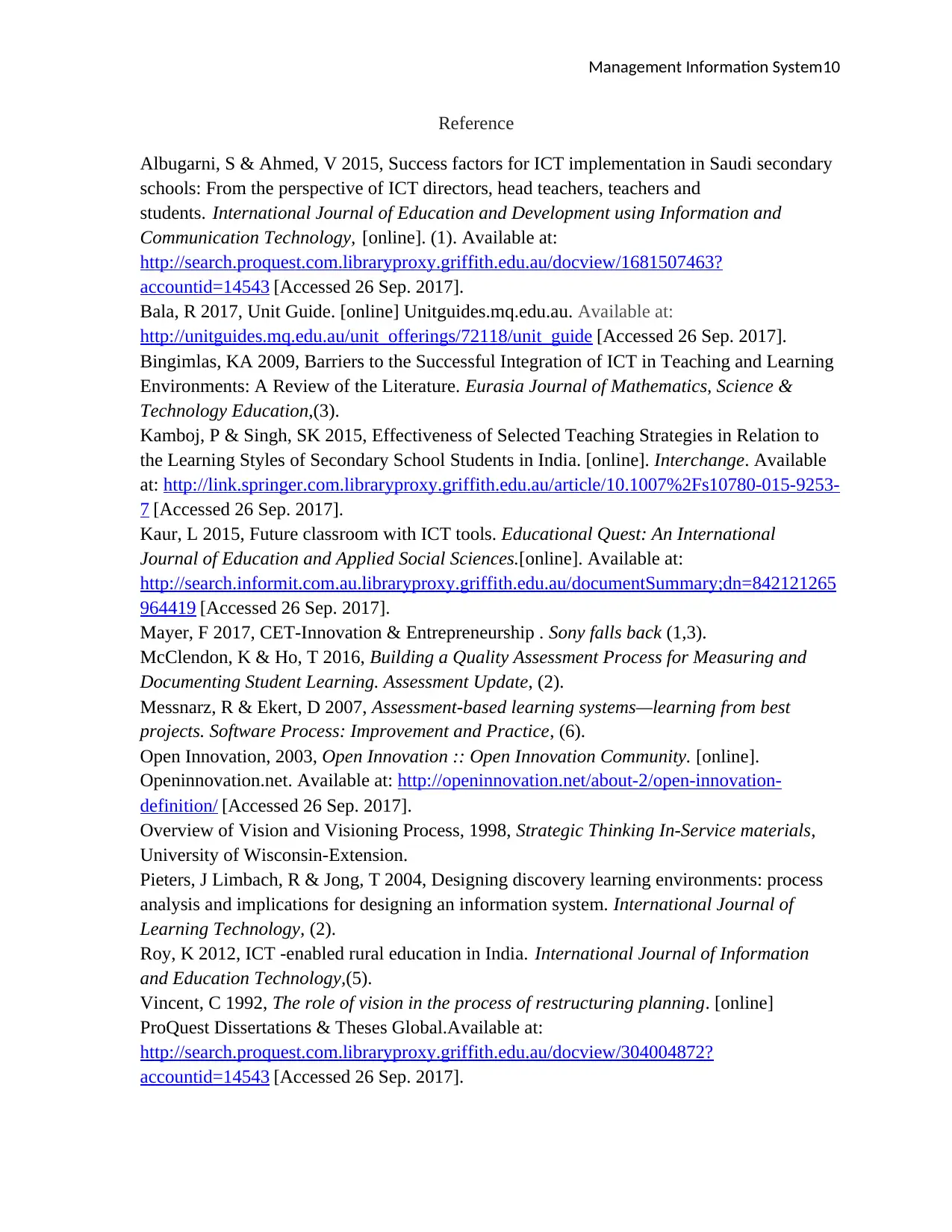
Management Information System10
Reference
Albugarni, S & Ahmed, V 2015, Success factors for ICT implementation in Saudi secondary
schools: From the perspective of ICT directors, head teachers, teachers and
students. International Journal of Education and Development using Information and
Communication Technology, [online]. (1). Available at:
http://search.proquest.com.libraryproxy.griffith.edu.au/docview/1681507463?
accountid=14543 [Accessed 26 Sep. 2017].
Bala, R 2017, Unit Guide. [online] Unitguides.mq.edu.au. Available at:
http://unitguides.mq.edu.au/unit_offerings/72118/unit_guide [Accessed 26 Sep. 2017].
Bingimlas, KA 2009, Barriers to the Successful Integration of ICT in Teaching and Learning
Environments: A Review of the Literature. Eurasia Journal of Mathematics, Science &
Technology Education,(3).
Kamboj, P & Singh, SK 2015, Effectiveness of Selected Teaching Strategies in Relation to
the Learning Styles of Secondary School Students in India. [online]. Interchange. Available
at: http://link.springer.com.libraryproxy.griffith.edu.au/article/10.1007%2Fs10780-015-9253-
7 [Accessed 26 Sep. 2017].
Kaur, L 2015, Future classroom with ICT tools. Educational Quest: An International
Journal of Education and Applied Social Sciences.[online]. Available at:
http://search.informit.com.au.libraryproxy.griffith.edu.au/documentSummary;dn=842121265
964419 [Accessed 26 Sep. 2017].
Mayer, F 2017, CET-Innovation & Entrepreneurship . Sony falls back (1,3).
McClendon, K & Ho, T 2016, Building a Quality Assessment Process for Measuring and
Documenting Student Learning. Assessment Update, (2).
Messnarz, R & Ekert, D 2007, Assessment-based learning systems—learning from best
projects. Software Process: Improvement and Practice, (6).
Open Innovation, 2003, Open Innovation :: Open Innovation Community. [online].
Openinnovation.net. Available at: http://openinnovation.net/about-2/open-innovation-
definition/ [Accessed 26 Sep. 2017].
Overview of Vision and Visioning Process, 1998, Strategic Thinking In-Service materials,
University of Wisconsin-Extension.
Pieters, J Limbach, R & Jong, T 2004, Designing discovery learning environments: process
analysis and implications for designing an information system. International Journal of
Learning Technology, (2).
Roy, K 2012, ICT -enabled rural education in India. International Journal of Information
and Education Technology,(5).
Vincent, C 1992, The role of vision in the process of restructuring planning. [online]
ProQuest Dissertations & Theses Global.Available at:
http://search.proquest.com.libraryproxy.griffith.edu.au/docview/304004872?
accountid=14543 [Accessed 26 Sep. 2017].
Reference
Albugarni, S & Ahmed, V 2015, Success factors for ICT implementation in Saudi secondary
schools: From the perspective of ICT directors, head teachers, teachers and
students. International Journal of Education and Development using Information and
Communication Technology, [online]. (1). Available at:
http://search.proquest.com.libraryproxy.griffith.edu.au/docview/1681507463?
accountid=14543 [Accessed 26 Sep. 2017].
Bala, R 2017, Unit Guide. [online] Unitguides.mq.edu.au. Available at:
http://unitguides.mq.edu.au/unit_offerings/72118/unit_guide [Accessed 26 Sep. 2017].
Bingimlas, KA 2009, Barriers to the Successful Integration of ICT in Teaching and Learning
Environments: A Review of the Literature. Eurasia Journal of Mathematics, Science &
Technology Education,(3).
Kamboj, P & Singh, SK 2015, Effectiveness of Selected Teaching Strategies in Relation to
the Learning Styles of Secondary School Students in India. [online]. Interchange. Available
at: http://link.springer.com.libraryproxy.griffith.edu.au/article/10.1007%2Fs10780-015-9253-
7 [Accessed 26 Sep. 2017].
Kaur, L 2015, Future classroom with ICT tools. Educational Quest: An International
Journal of Education and Applied Social Sciences.[online]. Available at:
http://search.informit.com.au.libraryproxy.griffith.edu.au/documentSummary;dn=842121265
964419 [Accessed 26 Sep. 2017].
Mayer, F 2017, CET-Innovation & Entrepreneurship . Sony falls back (1,3).
McClendon, K & Ho, T 2016, Building a Quality Assessment Process for Measuring and
Documenting Student Learning. Assessment Update, (2).
Messnarz, R & Ekert, D 2007, Assessment-based learning systems—learning from best
projects. Software Process: Improvement and Practice, (6).
Open Innovation, 2003, Open Innovation :: Open Innovation Community. [online].
Openinnovation.net. Available at: http://openinnovation.net/about-2/open-innovation-
definition/ [Accessed 26 Sep. 2017].
Overview of Vision and Visioning Process, 1998, Strategic Thinking In-Service materials,
University of Wisconsin-Extension.
Pieters, J Limbach, R & Jong, T 2004, Designing discovery learning environments: process
analysis and implications for designing an information system. International Journal of
Learning Technology, (2).
Roy, K 2012, ICT -enabled rural education in India. International Journal of Information
and Education Technology,(5).
Vincent, C 1992, The role of vision in the process of restructuring planning. [online]
ProQuest Dissertations & Theses Global.Available at:
http://search.proquest.com.libraryproxy.griffith.edu.au/docview/304004872?
accountid=14543 [Accessed 26 Sep. 2017].
Paraphrase This Document
Need a fresh take? Get an instant paraphrase of this document with our AI Paraphraser
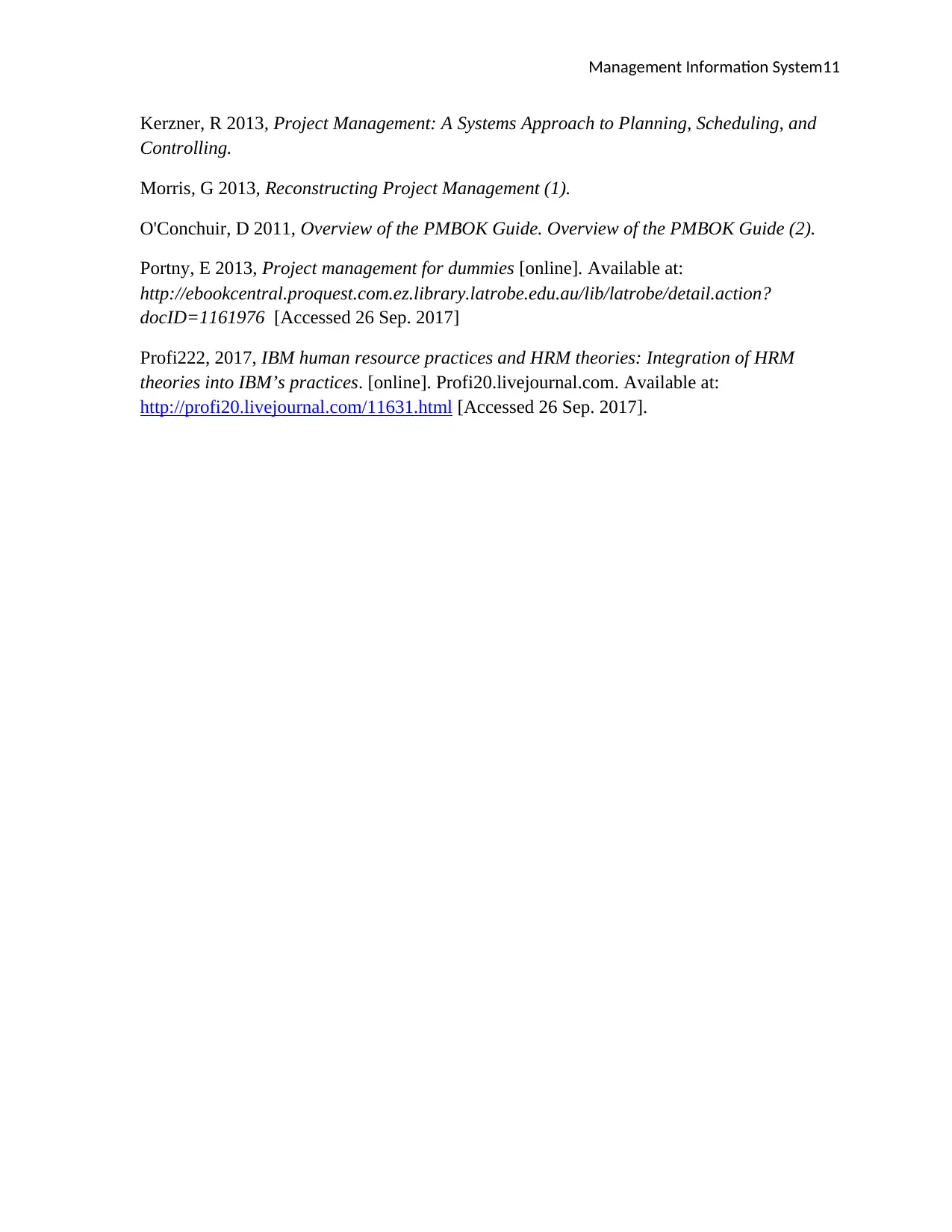
Management Information System11
Kerzner, R 2013, Project Management: A Systems Approach to Planning, Scheduling, and
Controlling.
Morris, G 2013, Reconstructing Project Management (1).
O'Conchuir, D 2011, Overview of the PMBOK Guide. Overview of the PMBOK Guide (2).
Portny, E 2013, Project management for dummies [online]. Available at:
http://ebookcentral.proquest.com.ez.library.latrobe.edu.au/lib/latrobe/detail.action?
docID=1161976 [Accessed 26 Sep. 2017]
Profi222, 2017, IBM human resource practices and HRM theories: Integration of HRM
theories into IBM’s practices. [online]. Profi20.livejournal.com. Available at:
http://profi20.livejournal.com/11631.html [Accessed 26 Sep. 2017].
Kerzner, R 2013, Project Management: A Systems Approach to Planning, Scheduling, and
Controlling.
Morris, G 2013, Reconstructing Project Management (1).
O'Conchuir, D 2011, Overview of the PMBOK Guide. Overview of the PMBOK Guide (2).
Portny, E 2013, Project management for dummies [online]. Available at:
http://ebookcentral.proquest.com.ez.library.latrobe.edu.au/lib/latrobe/detail.action?
docID=1161976 [Accessed 26 Sep. 2017]
Profi222, 2017, IBM human resource practices and HRM theories: Integration of HRM
theories into IBM’s practices. [online]. Profi20.livejournal.com. Available at:
http://profi20.livejournal.com/11631.html [Accessed 26 Sep. 2017].
1 out of 11
Related Documents
Your All-in-One AI-Powered Toolkit for Academic Success.
+13062052269
info@desklib.com
Available 24*7 on WhatsApp / Email
![[object Object]](/_next/static/media/star-bottom.7253800d.svg)
Unlock your academic potential
Copyright © 2020–2025 A2Z Services. All Rights Reserved. Developed and managed by ZUCOL.





